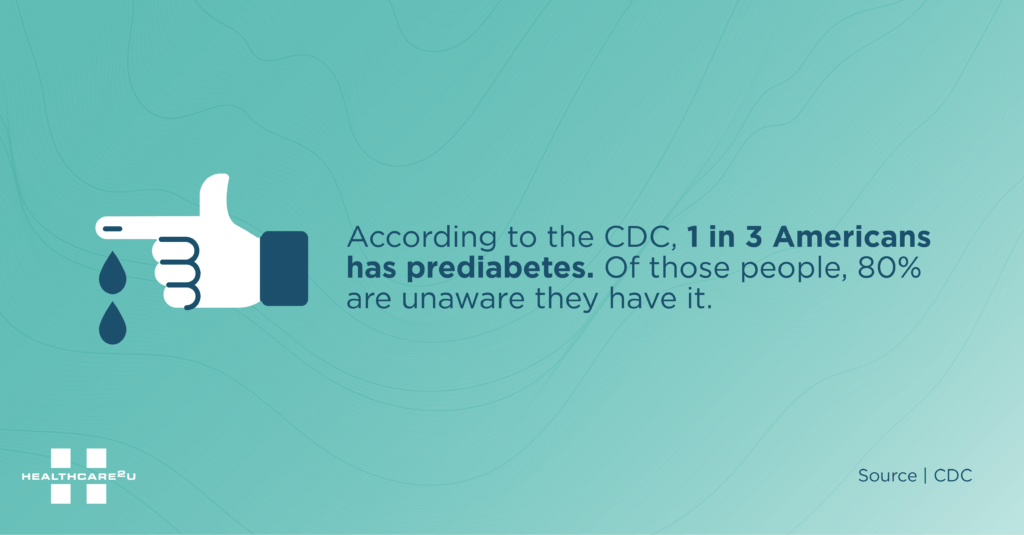Blog Posts
Prediabetes: When to Worry About the Precursor to Diabetes
Even if you haven’t been diagnosed with diabetes,
you may have prediabetes.
Have you ever heard of prediabetes? Few have, but it is an issue that — if left untreated — can evolve into a diabetes diagnosis. There are two types of diagnoses: type 1 and type 2. Type 1 diabetes often results from an autoimmune reaction and usually appears in adolescents and young adults. In contrast, type 2 develops over many years and is typically a result of poor diet and lack of exercise. What many people don’t know is that, if an individual has prediabetes, they are 70 percent more likely to end up developing type 2 diabetes. Let’s cover prediabetes’ risk factors, available tests, and the treatments for this sneaky precursor to diabetes.

What is Prediabetes?
Prediabetes is when your blood sugar levels are higher than usual but not high enough to be categorized as type 2 diabetes. A staggering 1 in 3 Americans has prediabetes. Of those people, more than 80 percent don’t know they have it.
What are the Risk Factors?
While there are usually no symptoms for prediabetes, the following list includes risk factors:
-
- Being overweight
- Being 45 years or older
- Having a family member with type 2 diabetes
- Being physically active less than three times a week
- Ever having gestational diabetes (diabetes during pregnancy) or giving birth to a baby who weighed more than nine pounds
- Having polycystic ovary syndrome
Race and ethnicity are also factors. According to the CDC (Centers for Disease Control) African Americans, Hispanic/Latino Americans, American Indians, Pacific Islanders, and some Asian Americans are at higher risk.
Blood Tests Available
If you have any risk factors listed above, the CDC suggests following up with your primary care physician to test your blood sugar levels. The following are blood tests available to check for prediabetes:
- Glycated hemoglobin (A1C) test — This test indicates your average blood sugar level for the past two to three months.
- Fasting blood sugar test — A blood sample is taken after fasting for at least eight hours (or overnight).
- Oral glucose tolerance test — This test is less commonly used than the others, except during pregnancy. You’ll fast overnight and then drink a sugary liquid at the primary care provider’s office or lab testing site. Blood sugar levels are then tested periodically for the next two hours.
How to Treat Prediabetes
The good news regarding prediabetes is that it can be reversed through lifestyle changes if caught early. If you are concerned or have tested within the prediabetic range, have a conversation with your primary care physician. In the meantime, here are a few common steps to begin treatment for prediabetes:
- Eating healthier
- Deal with stress
- Lose excess weight
- Exercise at least 150 minutes (about two and a half hours) a week
- Stop smoking
- If you’re at considerable risk, your healthcare provider may recommend medication
Prediabetes is a problem far more prevalent than you may think, and it has alarming statistics to back it up. One issue contributing to these statistics is people do not realize that prediabetes has no symptoms, and you can live with it for years before it develops into a more serious condition. Due to a lack of education, among other reasons, many people delay seeking medical care unless a condition is seen as urgent.
Delaying medical care can have serious repercussions, especially regarding chronic diseases. At Healthcare2U, we aim to eliminate barriers to primary care and the ongoing treatment of manageable disease states. Our Direct Primary Care (DPC) membership offers unlimited treatment and management of 13 chronic diseases, including diabetes. Membership is an affordable way to — not only manage chronic diseases — but to access care before a serious illness develops. Click here to learn more about how Healthcare2U’s membership benefits our members.
Blog Posts
News
Uncategorized
Blog Posts
News
Blog Posts
Blog Posts
News
Blog Posts
Blog Posts
Blog Posts
Blog Posts
Blog Posts
Blog Posts
Blog Posts
Blog Posts
Blog Posts
Blog Posts
Blog Posts
Blog Posts
Blog Posts
Blog Posts
Blog Posts
Blog Posts
Blog Posts
Blog Posts
Blog Posts
Blog Posts
Blog Posts
Blog Posts
Blog Posts
Blog Posts
Blog Posts
Blog Posts
Blog Posts
Blog Posts
Blog Posts
Blog Posts
Blog Posts
Blog Posts
Blog Posts
Blog Posts
Blog Posts
Blog Posts
Blog Posts
Blog Posts
Blog Posts
Blog Posts
Blog Posts
Blog Posts
Blog Posts
Blog Posts
Blog Posts
Blog Posts
Blog Posts
Blog Posts
Blog Posts
Blog Posts
Blog Posts
Blog Posts
Blog Posts
Blog Posts
Blog Posts
Blog Posts
Blog Posts
Blog Posts
Blog Posts
Blog Posts
Blog Posts
Blog Posts
Blog Posts
Blog Posts
Blog Posts
Blog Posts
Blog Posts
Blog Posts
Blog Posts
Blog Posts
Blog Posts
Blog Posts
Blog Posts
Blog Posts
Blog Posts
Blog Posts
Blog Posts
Blog Posts
Blog Posts
Blog Posts
Blog Posts
Blog Posts
Blog Posts
Blog Posts
Blog Posts
Blog Posts
Blog Posts
Blog Posts
Blog Posts
Blog Posts
Blog Posts
Blog Posts
Blog Posts
Blog Posts
Blog Posts
Blog Posts
Blog Posts
Blog Posts
Blog Posts
Blog Posts
Blog Posts
Blog Posts
Blog Posts
Blog Posts
Blog Posts
Blog Posts
Blog Posts
Blog Posts
Blog Posts
Blog Posts
Blog Posts
Blog Posts
Blog Posts
Blog Posts
Blog Posts
Blog Posts
Blog Posts
CONTACT US
BECOME A PART OF THE SOLUTION
Redefine the healthcare experience with No-Claims Healthcare™